Morris & Fan. Reservoir Sedimentation Handbook
Подождите немного. Документ загружается.

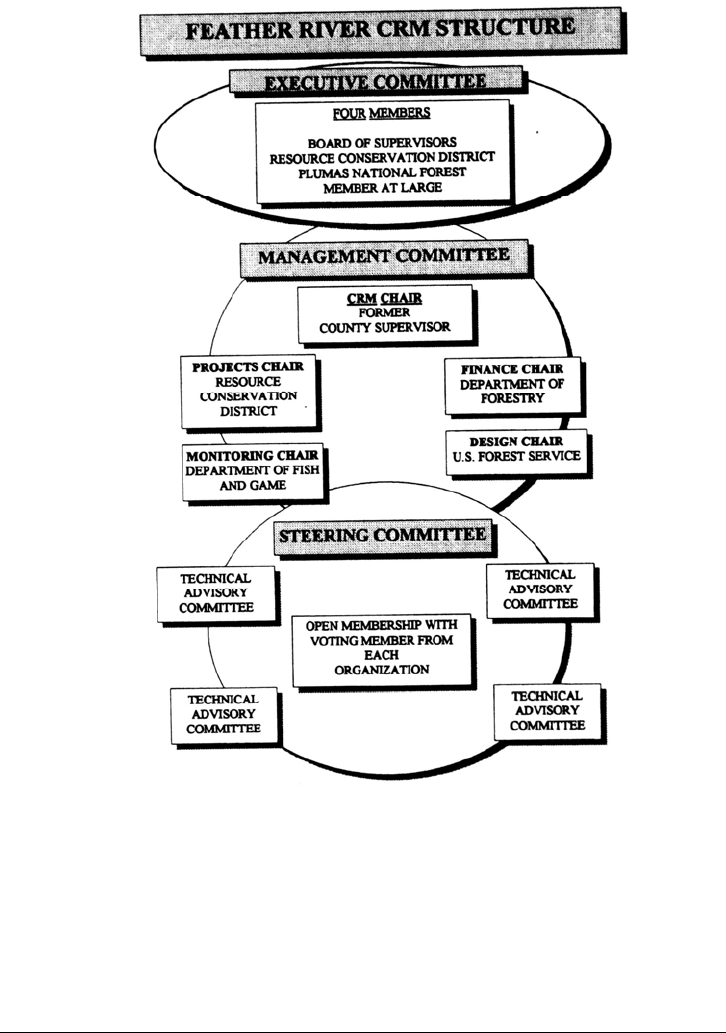
NORTH FORK FEATHER RIVER, CALIFORNIA, USA 22.10
technical assistance committees composed of interdisciplinary teams of resource
specialists, landowners, and managers, which provide technical expertise and direction
through the planning, execution, and monitoring phase of individual projects.
FIGURE 22.4 Organizational structure of Coordinated Resource Management group, East
Branch North Fork Feather River (Clifton, 1994).
22.4 SAMPLE STREAM RESTORATION ACTIVITIES
22.4.1 Red Clover Creek Demonstration Project
The Red Clover Creek demonstration project, constructed in 1986 and 1987, is an
example of instream channel rehabilitation. This project was described by Lindquist et al.
(1995).
Prior to 1880, the Red Clover Creek had a narrow, small stable channel
including a well-developed riparian zone with hardwoods, willows, and sedges that
protected streambanks. Flood flows overflowed out of the narrow channel and onto the
adjacent meadows, thereby reducing the flood peak, dissipating erosive energy into

NORTH FORK FEATHER RIVER, CALIFORNIA, USA 22.11
shallow overbank flow, and recharging the water table in the riparian meadow wetland
area. However, by 1985 the loss of riparian vegetation and the process of channel
degradation had produced an actively eroding channel 15 to 18 m wide with vertical
bank cuts up to 3 m tall, eroding about 490,000 m
3
of sediment out of the channel system
in the process. As a result of channel incision and widening, the groundwater table was
lowered, dewatering soils and converting wet riparian meadows into dry sagebrush-dominated
lands. Prior to the project, the demonstration area was composed primarily of xeric species
of undesirable shrubs and grasses such as sagebrush, rabbitbrush, and cheatgrass. Two
project objectives were established: stabilize streambanks to reduce erosion and raise the
water table to restore meadow habitat.
Rehabilitation activity on the 1.6-km demonstration reach of Red Clover Creek
consisted of four major elements:
1. A 28-ha riparian corridor was fenced, and grazing and vehicles were excluded.
2. Four rock check dams were constructed to establish higher water levels and control
erosion.
3. Streambanks were stabilized by wood revetment and revegetated using native
species including aspen, alder, willow, and grasses.
4. Monitoring of water table, vegetation, fisheries, wildlife habitat, and channel
morphology was conducted over a 10-year period.
The structural elements of this project are located in Fig. 22.5.
FIGURE 22.5 Location map of restoration activities on Red Clover Creek.
The total structural height of the check dams was 2 to 3 m, and they were keyed about
3 m into the streambanks to ensure the abutments would not wash out. The four dams
required 1920 m
3
of rock, blasted from a nearby outcrop, plus local soil which was
compacted to form the impermeable core. To reduce discharge velocity the aprons
extending downstream of the spillway crest were constructed at a flat 10:1
(horizontal:vertical) slope. Spillways were designed for the 10-year discharge. In the
meandering stream it was important to orient spillways in a direction that did not discharge
against and erode downstream channel banks.
Channel morphology was monitored for evidence that the channel was stabilizing,
but geomorphic data were of insufficient detail to quantify changes. Because large
changes did not occur, the 10-point cross sections taken at the beginning of the project
did not offer sufficient detail to monitor results. Very little sediment, possibly a few
hundred cubic meters, accumulated behind the check dams during the monitoring
NORTH FORK FEATHER RIVER, CALIFORNIA, USA 22.12
period. Because of the slow changes which normally occur, some types of monitoring
(e.g., geomorphic change) should be scheduled at multiyear rather than annual intervals,
or following large flood events.
The check dams immediately elevated groundwater levels, which allowed the rapid
establishment of riparian and wetland vegetation. There was a dramatic increase in
vegetation biomass and diversity within about 60 m of the stream, and vegetation
changed to more desirable mesic (moist) species, as opposed to the xeric (dry) species
previously dominating in the area. The before and after photographs taken at a
permanent photo point (Fig. 22.6) illustrate the dramatic recovery in riparian vegetation.
No change in vegetation occurred away from the channel in control areas unaffected by
the raised water table.
In the fenced control area downstream of the last check dam and thus not affected by
increased groundwater levels, a remarkable improvement in vegetation was observed
after 4 years. The channel narrowed and began to meander, riparian vegetation
reestablished along the banks, fish became established, and bank stability improved. This
suggested that grazing exclusion alone may be sufficient for stream rehabilitation under
favorable circumstances. Although natural rehabilitation is relatively slow, it is much
less costly than the construction and maintenance of structural measures such as check
dams.
During the first 8 years of the project, there was no grazing within the 28-ha
enclosure. At the end of this period vegetation was thriving within the enclosure, in
contrast to conditions outside the enclosure where heavy grazing removed most
vegetation and left soils vulnerable to erosion. During the ninth year, late-season grazing
within the enclosure was planned for a 5-day period, but the cattle were left in the
enclosure for several weeks, denuding the vegetation and trampling channel banks.
Although significant regrowth occurred during the following summer, mechanical
damage to stream- banks from the cattle was still evident one year later and slow to
heal.
Avian species diversity increased by 21 percent and avian density increased by 96
percent in the demonstration area as compared to the control area, with a total of 94
species observed. Seventeen waterfowl species were observed in the demonstration
area, compared to nine in the control area, and waterfowl use was 700 percent greater
than in the control. Over a 4-year study period from 1988-1991, there were 588
ducklings produced in the demonstration area compared to 23 in the control area. The
project area also provided refuge for threatened or at-risk avian species. Trout
populations increased, but no areas suitable for spawning were produced by the project.
The establishment of a beaver population hindered stream rehabilitation. A beaver
dam was constructed on top of check dam 4, elevating the water level more than
originally intended. This caused the stream to overflow its banks, flood meadows, and
then reenter the stream farther downstream, causing bank failure and headcutting.
Also, beaver depredation of willows and other hardwoods for food and dam-building
materials hindered revegetation. Control of the beaver population is essential in the early
project phase before vegetation has become well-established.
Project costs and funding sources are itemized in Table 22.4. The table does not
include the personnel costs of participating state and federal agencies or the value of
donated materials.
Several practical conclusions emerged from the project. The use of permanent photo
points provided an effective qualitative documentation of trends over time, but low-
altitude infrared aerial photography was most useful for monitoring vegetative changes.
Native seed mixes were found to germinate more slowly than commercial seeds, but
provided effective erosion protection, and their use is encouraged. Check dams are
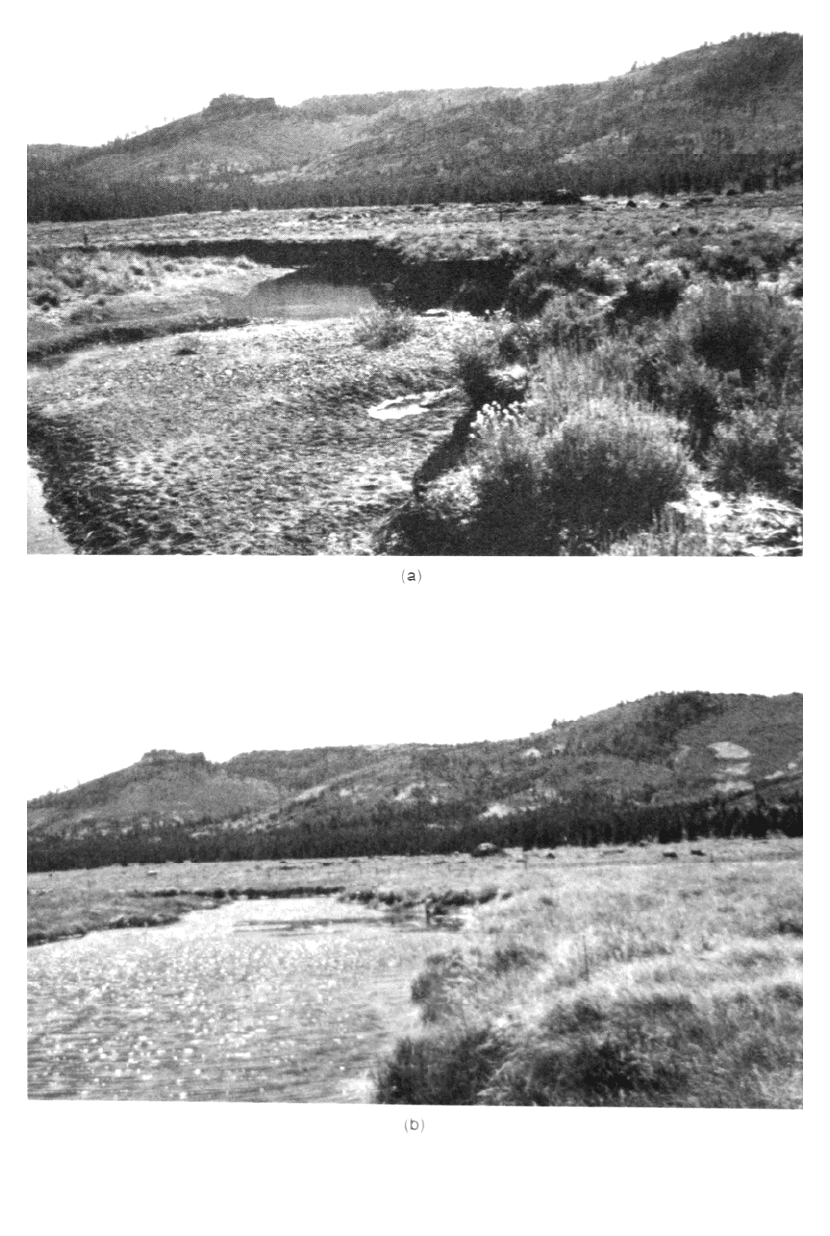
NORTH FORK FEATHER RIVER, CALIFORNIA, USA 22.13
(a)
(b)
FIGURE 22.6 Red Clover Creek: (a) before restoration and (b) after restoration (D. Lindquist).

NORTH FORK FEATHER RIVER, CALIFORNIA, USA 22.14
TABLE 22.4
Red Clover Creek Demonstration Project, Cost Sharing
Project Cooperator Funding, $
Pacific Gas and Electric Co.:
Design and construction 11,500
10 years monitoring: biology, geomorphology, groundwater 100,000
Private landowner:
Donated rock, excluded cattle -
California Department of Forestry:
Check dam construction, cultural resource study 41,000
California Department of Fish and Game: -
Fencing, design assistance 20,000
U.S. Forest Service, Plumas National Forest:
Rock blasting, design, donated trees for revetment -
U.S. Department of Agriculture, Natural Resource Conservation Service:
Check dam design -
Total (does not include personnel costs for agencies or donations) 185,590
Source: Plumas Corp. (1996).
expensive, require regular maintenance, and are not a panacea to correct erosion
problems. Improved grazing management, revegetation, and exclusion fencing of the
riparian corridor can dramatically improve degraded channels on some sites and
should always be evaluated as an alternative to more costly structural measures. The first
several years following installation are critical because vegetation has not yet become
established and it can easily be washed out by large floods. Maintenance expenditures
should be anticipated.\
22.4.2 Big Flat Meadow Restoration Project
Restoration work in Big Flat Meadow, which had been severely degraded by gullying
of Cotton Creek, was performed in 1995 with revegetation in 1996. This project
exemplifies channel replacement and is described by Plumas Corp. (1996).
Continuous grazing under permit was initiated in Cottonwood Creek in 1910, and
severe erosion was evident by the 1930s. By 1990 the stream had gullied to a depth of
5 m in some places where it crossed Big Flat Meadow and large volumes of sediment
were exported because of channel erosion. Dewatering of riparian areas due to stream
incision, steep banks, and continued mechanical damage by cattle all combined to prevent
restabilization of streambanks. As the meadow dried out and vegetation changed from
grasses to sagebrush, average meadow forage production dropped to 10 kg/ha from values
formerly in the 17- to 28-kg/ha range. Nevertheless, grazing pressure since 1957 continued
to be high, between 93 and 200 percent of the allowable use.
The agencies and individuals in the CRM group worked cooperatively to undertake
the Big Flat Meadow rewatering project to restore the original geomorphic conditions
of a stable meandering channel-floodplain system. The project had four major
objectives: (1) reduce the amount of sediment exported and improve downstream water
quality, (2) restore spawning and rearing habitat for rainbow trout by augmenting
summer base flow, (3) elevate groundwater levels to restore wetland conditions in the
meadow, and (4) demonstrate stream restoration technology that can be applied to other
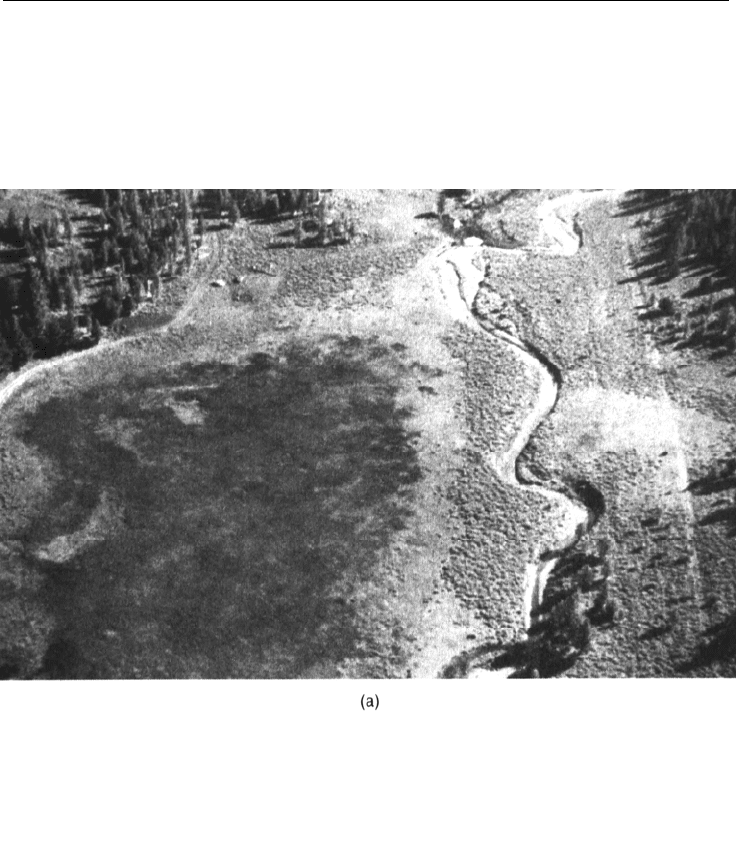
NORTH FORK FEATHER RIVER, CALIFORNIA, USA 22.15
degraded sites. The rewatering project restored 19 ha of meadow, increasing the grazing
resource for both cattle and wildlife.
Project design included both structural and nonstructural measures. The structural
measures consisted of creating a 1.2 km shallow meandering channel crossing the
meadow along a new alignment, with rock pools in the steepest sections of the new
channel to protect against gullying. The gullied channel was backfilled and converted
into a chain of seven ponds to create wildlife habitat. The overall configuration of the
meadow in the original and restored conditions is shown in the aerial photos in Fig.
22.7a and b, and the changes in the channel cross section are illustrated in Fig. 22.8.
Nonstructural measures focused on revegetation by replanting and reduction of grazing.
Changes in the total grazing allotment were relatively small, a 12 percent reduction from
1268 to 1118 animal unit months per year. The most important change was a substantial
(85 percent) reduction of grazing pressure in the riparian areas and improved pasture
rotation (see Table 22.5). Cost sharing for the project is summarized in Table 22.6.
22.5 COST AND BENEFIT OF WATERSHED RESTORATION
It is difficult to determine both the cost and the benefit of watershed restoration. The
published dollar costs for projects do not include the personnel cost of agency staff, nor is
volunteer time shown as a cost. Benefits are far more difficult to quantify. Obvious benefits
include reduced sedimentation at the downstream dams. The computation of sediment
reduction benefits to PG&E (and ultimately to their utility customers) are described below,
but do not include any benefits at the large Oroville Reservoir further downstream, where all
sediments eventually deposit but which does not belong to PG&E. Other directly tangible
FIGURE 22.7 (a) Oblique aerial photo of Big Flat Meadow with the gullied pre-
p
roject
Cottonwood Creek.
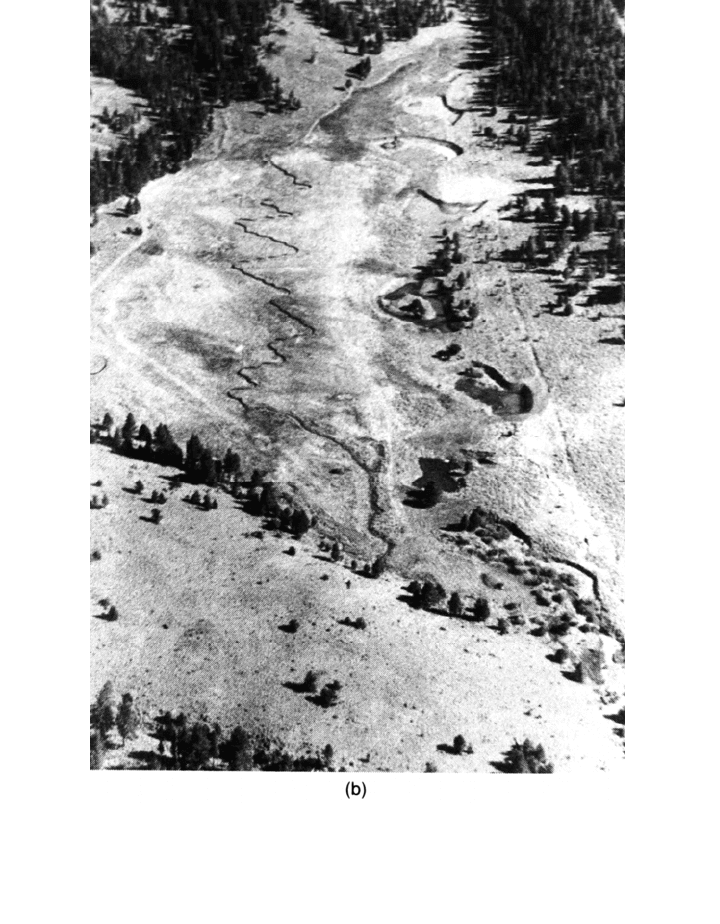
NORTH FORK FEATHER RIVER, CALIFORNIA, USA 22.16
benefits include increased forage in meadows. Less economically tangible but no less
important are benefits to overall ecosystem integrity, wildlife, and biodiversity. Only some of
these environmental benefits can be translated into direct economic benefits through
recreational activities (such as trout fishing). Recreational use of Plumas National Forest
amounts to 2.3 million visitor-days per year. The East Branch also provides inflow into
California's State Water Project. (Clifton, 1994).
FIGURE 22.7 (b) Oblique aerial photo of Cottonwood Creek showing new alignment of
the low-flow channel, with the gullied channel refilled and converted into a chain of ponds. (C.
Clifton).
22.5.1 Overview of Project Costs
More than 30 projects have been completed under the purview of the CRM group. Cost
data on 10 projects involving the rehabilitation of significant lengths of streams have
been summarized in Table 22.7.
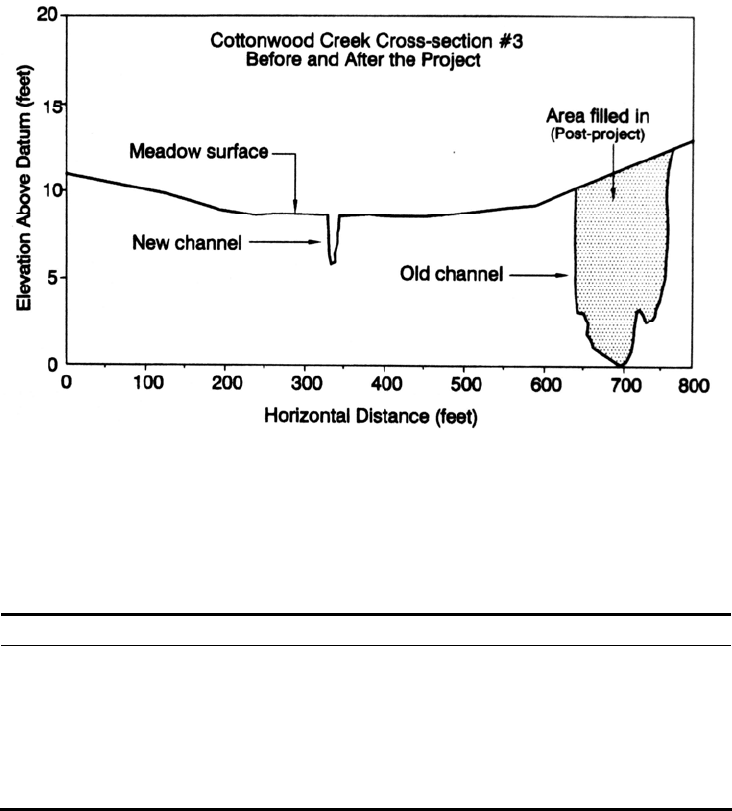
NORTH FORK FEATHER RIVER, CALIFORNIA, USA 22.17
FIGURE 22.8 Cross section of Cottonwood Creek in Big Flat Meadow, showing the
replacement of the original severely eroded stream with a new shallow low-flow (1.1 m
3
/s
capacity) channel which will overflow onto the meadow during high discharges, and
which promotes higher groundwater levels
b
ecause of the higher channel invert
elevation
(
Plumas Cor
p
., 1996
)
.
TABLE 22.5 Grazing Management Changes, Big Flat Meadow Area
Preproject
Postproject
Allowed grazing 317 AU for 4 months 317 AU for 3 months
and 167 AU for 1 month
Total AU months 1268 1118
R
iparian pasture use 2-3 weeks/yr 2-3 days/yr
Grazing system Two-pasture deferred grazing Five-pasture rotation
with 4.8-km new fence
AU = animal units. Each AU is equivalent to a cow-calf pair or 5 sheep.
Source: Plumas Corp. (1996).
22.5.2 PG&E Economic Justification for Watershed Protection
Activities
Between 1984 and 1995 PG&E invested approximately $1.1 million to partially fund
administration of the CRM group by the Plumas County Development Corp. and to
implement projects contributing directly to the reduction of sediment reaching Rock
Creek and Cresta Reservoirs. Originally this investment was easily justified by the
exclusion of sediment which would otherwise need to be removed from reservoirs by
costly dredging. However, development of an economical sediment routing strategy
which is expected to eliminate the need for maintenance dredging undercut this basis for
justifying expenditures in the watershed program. Harrison and Lindquist (1995) exam-

NORTH FORK FEATHER RIVER, CALIFORNIA, USA 22.18
TABLE 22.6 Big Flat Meadow Rewatering Project, Cost Sharing (Plumas Corp., 1996).
Project cooperator Funding, $
U.S. Forest Service, Plumas National Forest:
Construction funding 30,000
Design and assessment work 5,590
Rock, 350 1-m boulders 10,000
Aerial photos and mapping 13,000
Fencing 10,000
Pacific Gas and Electric Co.:
Revegetation 13,000
Hydrologic monitoring 25,000
State Water Resources Control Board:
Construction funding 70,000
Grazing permittee:
Fencing 2,000
Plumas County Community Development Commission:
Design 7,000
Total (funds and in-kind contributions) $ 185,590
TABLE 22.7 Cost of Stream Rehabilitation in Plumas County
Site Year Cost, $ Length treated, m Unit cost, $/m
Red Clover Creek 1 1986 172,000 1,610 107
Poco Creek 1986-1989 128,000 366 350
Wolf Creek I, 2, 3 1989-1990 850,000 2,938 289
Greenhorn Creek 1991 406,000 854 476
Clarks Creek 1992-1994 24,000 610 39
Haskins Creek 1993 40,000 244 164
Red Clover Creek 2 1994-1995 39,000 793 49
Big Flat Meadows 1995 189,000 1,235 153
Jamison Creek 1995 180,000 610 295
Poplar Creek 1994-1995 35.000
122 287
Total or average
2,063,000 9,380 220
Source: Plumas Corp. (1996).
-ined the potential economic benefits to PG&E from improved watershed management,
in the absence of savings from reduced dredging.
On the anticipation that 15 watershed projects completed or proposed during 1991
could produce a 5 or 6 percent reduction in sediment yield, it was estimated that a 50
percent reduction in sediment yield at the downstream reservoirs is reasonably achievable
within the next 30 years. The downstream benefits of watershed restoration were based
on this scenario.
Suspended sediment is estimated to increase annual overhaul costs by approximately
$150,000 (in 1995 dollars) for the six turbines in the North Fork Feather River

NORTH FORK FEATHER RIVER, CALIFORNIA, USA 22.19
system. Assuming turbine wear declines in proportion to reduced sediment inflow,
annual savings of $75,000 may be achieved at the end of 30 years.
Erosion of turbines by sediment reduces their efficiency. Assuming a 1 percent
efficiency degradation due to sediment, a 0.5 percent increase in efficiency
achieved by a 50 percent reduction in suspended sediment would increase power
generation by about 9×10
6
kWh/yr at the three power stations.
Improved watershed management can increase base flow and change the shape of
runoff hydrographs by reducing the storm peak. This effect was assumed to reduce
the amount of spills in the system by 5 percent at the end of 30 years, which
represents only 0.4 percent of the average 2×10
9
m
3
/yr inflow to Rock Creek
reservoir. This represents an additional 8.3×10
6
m
3
of water available for power
generation, equivalent to an additional 6.7×10
6
kWh annually.
In summary, watershed protection could eventually result in an additional 15.7×10
6
kWh/yr, much of this valuable peaking power, plus $75,000/yr in reduced turbine
maintenance costs.
22.6 RESERVOIR SEDIMENTATION
Bathymetry in the vicinity of Rock Creek Dam (Fig. 22.9) shows the scour of sediment
deposits on the outside of the bend, and the scour cone at the existing small-capacity low-
level outlet pipes. Sediments deposited in both Rock Creek and Cresta Reservoirs contain
a large percentage of silt-size material, and at both sites the sediments are predominately in
the sub-0.84 mm (medium sand) size range which is most deleterious to spawning gravels.
Release of the fine sediments presently stored behind the dams would adversely affect
fisheries. The Feather River was heavily mined for gold during the nineteenth century.
Analysis of some of the initial sediment samples from the reservoir revealed a significant
gold content, raising the interesting possibility that the reservoir sediments might be an
economic resource rather than a liability. However, a subsequent boring and assay
program revealed that the amount of gold in the reservoir was not significant (Alpha
Geotechnical, 19876).
22.7 RESERVOIR DREDGING
Sediment control efforts initially focused on the dredging of accumulated sediments from
the reservoir rather than on establishing equilibrium conditions across the impounded
reaches. An environmental impact report was prepared for the proposed dredging which
described the selected dredging strategy, several dredging alternatives, and project
environmental requirements (Planning Associates, 1991). The most important dredging
limitations at this site are the stringent water quality requirements and the lack of suitable
large-volume disposal sites. The canyon floor is narrow, with a railroad running along
one bank and State Highway 70 running along the other bank and frequent tunnels on
both routes. The removal and disposal of a large volume of sediment would require a
sediment storage area below the canyon reach and a sediment transport distance exceeding
40 km. Disposal options evaluated included long-distance trucking, rail transport, and
slurry pipeline. All were very costly. Consequently, a small-volume dredging job was
proposed which would not exceed the fill capacity at the Rogers Flat area, located in the
canyon between Rock Creek and Cresta Reservoirs. Because sediment inflow and
discharge had already stabilized at Poe Reservoir, no dredging was proposed there.
